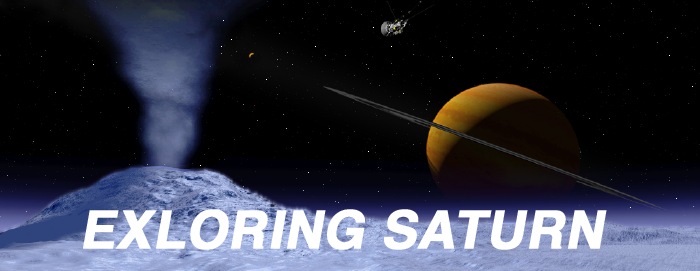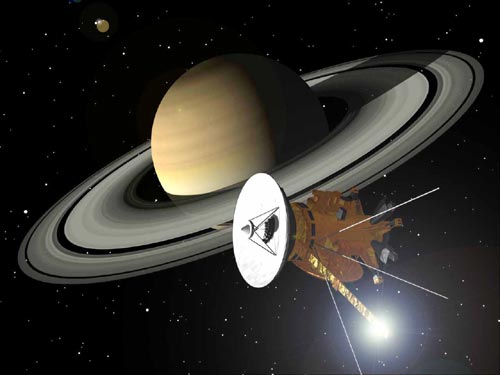 |
|||||||
| One of the Most Complex and Ambitious Ventures in the History of Space Exploration | |||||||
| Saturn | Rings | Moons | Titan | Cassini | Science | Huygens | Resources |
Exploring the Saturn system:
Some Important Cassini Findings So Far
THE LATEST CASSINI NEWS FROM SATURN »»
Cassini arrived in orbit around Saturn on July 1, 2004. The spacecraft's navigation has been precise and its science instruments and radio reporting system are working well. So far, the spacecraft has been sending home eye-opening data about the planet Saturn and its moons and rings.

CASSINI AT SATURN
click to enlarge nasa art
About the large moon Titan...About the Huygens landing...
- Although it is a moon, Titan is more than one-third the diameter of Earth and larger than the planets Mercury and Pluto. The surface temperature of the moon is minus 290 degrees Fahrenheit.
Navigators will fly Cassini close to Titan a total of 45 times as it circles Saturn. Cassini snapped pictures from a distance of 210,000 miles as it rushed into orbit around Saturn on July 1, 2004, The spacecraft flew within 746 miles of Titan on October 26, 2004. The spacecraft's closest pass will be in 2006 when Cassini navigates within 590 miles of the moon's surface.
- New images of the exotic moon, snapped by Cassini from a distance of 210,000 miles as it rushed into orbit around Saturn on July 1, 2004, seemed to show through the haze a ridged surface of ice that may have been cracked repeatedly by Titan-quakes.
Astronomers did not see the lakes and oceans of liquid methane they had expected to find under Titan's orange sky. Scientists had figured the methane gas in Titan's nitrogen-rich atmosphere should rain continuously on the surface. That, in turn, would require a lake or ocean from which methane could evaporate up into the atmosphere from where it could rain down again.
The Cassini photos did reveal clouds of methane floating under the haze about nine miles above the surface near the moon's south pole. Scientists had thought there would be more of the clouds around the globe raining methane on the surface.
- The July 1, 2004, photos of Titan from a distance of 210,000 miles seemed to show light-colored ice plateaus smeared with hydrocarbon tar. There also seemed to be dark-colored ice plateaus. The light and dark areas seemed to be crashing into each other, which suggested a volatile surface of ice cracked by Titan-quakes.
The lines where plateaus joined were blurry, indicating geologic activity such as wind-driven erosion. Since no craters were seen, planetary geologists wonder if the marks of small bodies crashing into Titan might have been erased quickly by winds or flows from volcanos. They assumed such meteroite-like impacts would be common because of the vast source of debris in Saturn's extensive rings.
- During the October 26, 2004, flyby, Cassini aimed its radar through the moon's atmospheric haze and record images in infrared and visible light. They were sharper than the July 1, 2004, photos because Cassini was much closer to Titan.
About the planet's rings...
- The picture became a great deal more clear on January 14, 2005, as Cassini's small probe named Huygens parachuted through Titan's atmosphere to the surface.
- Cassini released Huygens on December 24, 2004, Christmas Eve.
- On January 14, 2005, the 722-lb. probe carrying six science instruments and cameras punched into Titan's atmosphere at 12,400 mph. Temperatures of 21,600 degrees developed on the heat shield.
- After its speed dropped to to 870 mph, Huygens deployed parachutes. The probe floated downward for about 2.5 hours. Its landing speed was about 15 mph.
- As the probe parachuted to the surface of Titan, Cassini was flying overhead to receive and relay Huygens data about the chemistry of the moon's atmosphere and surface.
- Huygens seems to have landed on solid ground from which it transmitted data for 30 minutes until its battery ran down and Cassini passed out of radio range.
About Cassini's future...
- Astronomer's previously had lettered Saturn's seven main rings A through F in order of their discovery. As it flew into the Saturn system, Cassini's Ultraviolet Imaging Spectrograph recorded striking images of some of the rings.
- The seven main rings contain a large number of wavy, braided ringlets.
- The images revealed Saturn's A, B and C rings are dirty with a mix of mud and small ice particles. The NASA JPL team wonders whether the dirty rings were formed that way originally or were contaminated by micro-meteorites.
- Several tiny shepherd moons orbit within the gaps between the main rings, scalloping the ring edges. The small moonlets are only a few miles across.
Cassini-Huygens is a partnership between NASA, European Space Agency and Italian Space Agency.
- Cassini will fly by seven of Saturn's 31 known moons.
- Cassini's main program is scheduled to end with a Titan flyby on July 31, 2008.
- That will be the probe's 70th encounter with one or another of Saturn's moons.
- The Cassini mission is likely to continue beyond 2008 because the flawless maneuver into orbit around Saturn in 2004 didn't waste any fuel. There may be sufficient propellant to continue the mission for years.
| Top of this page | Saturn main page | The Planet | The Rings | The Moons | Solar System |
| Cassini probe | Cassini Science | Titan moon | Huygens | Internet Resources | |
| STO Cover | Search STO | Questions | Copyright 2005 Space Today Online | ||